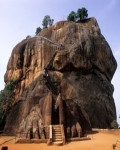Sigiriya
Archaeology »
Archaeological Monuments » Sigiriya
Sigiriya -
Sigiriya is located in landscape garden.
Sigiriya monument was established on 1987.
Primary threats to Sigiriya :
Mahavamsa entitled "The Ten Kings" dealing with the reign of Dhatusena followed by the next chapter on "The Two Kings" which is about Kasyapa and Mugalan (Mogallana).
Historical facts of Sigiriya :
- Sigiriya, also known as the Lion Rock, is a historical and archaeological marvel located in the Central Province of Sri Lanka. It is one of the country's most iconic and significant landmarks, recognized as a UNESCO World Heritage Site. Sigiriya's historical facts encompass its ancient rock fortress, extensive gardens, and breathtaking frescoes, making it a fascinating testament to Sri Lanka's rich cultural heritage.
- Sigiriya's history dates back to the 3rd century AD when it was developed as a fortress and citadel by King Kashyapa I of the ancient kingdom of Anuradhapura. According to historical accounts, King Kashyapa seized the throne by overthrowing his father, King Dhatusena, and fearing reprisal from his half-brother Moggallana, he moved the royal capital to Sigiriya for enhanced security.
- The defining feature of Sigiriya is the massive rock column rising approximately 200 meters (660 feet) above the surrounding plains. The rock is an ancient volcanic plug, which explains its unique and imposing formation. The king transformed the summit of the rock into a fortified palace complex, complete with lavish gardens, ponds, and sophisticated water management systems.
- One of the most remarkable aspects of Sigiriya is the Lion Gate, an impressive entrance to the fortress. The gate was constructed in the form of a giant lion's head, and visitors had to pass through its mouth to access the palace on top. Unfortunately, over time, the lion's head has eroded, leaving only the massive paws visible.
- As a significant cultural center, Sigiriya also housed some extraordinary frescoes that adorned the walls of a sheltered rock overhang. These frescoes, known as the "Sigiriya Damsels," are believed to represent celestial nymphs or women from the royal court. They display exceptional artistic skill and reveal insights into the fashion and aesthetics of ancient Sri Lanka.
- The gardens surrounding Sigiriya are an integral part of its historical significance. The complex features symmetrically laid-out gardens with a sophisticated irrigation system that showcases the advanced engineering knowledge of the time. The gardens are divided into terraces with fountains, ponds, and waterways, creating an oasis-like atmosphere in the heart of the arid region.
- King Kashyapa's reign at Sigiriya was relatively short-lived, as he was defeated by his half-brother Moggallana in 495 AD. Subsequently, Sigiriya was abandoned and used as a Buddhist monastery until the 14th century. Over the centuries, the site was lost to history and reclaimed by the jungle.
- It wasn't until the early 20th century that Sigiriya was rediscovered by British archaeologists. Excavations and restoration efforts began, revealing the astonishing beauty and historical significance of the site. Today, Sigiriya is a popular tourist destination, attracting visitors from around the world who come to admire its ancient grandeur and learn about Sri Lanka's rich history.
- Sigiriya's importance as a UNESCO World Heritage Site lies in its outstanding cultural and historical value. It is not only a testament to ancient architectural ingenuity but also provides valuable insights into the political, social, and artistic aspects of Sri Lanka during the 3rd century AD.
- To preserve and protect the site, measures have been taken to limit the number of visitors allowed to ascend the rock each day. Additionally, efforts are ongoing to maintain and restore the frescoes and other structures, ensuring that future generations can continue to appreciate and learn from this extraordinary historical treasure.
- In conclusion, Sigiriya, the Lion Rock of Sri Lanka, is a fascinating historical site that showcases the brilliance of ancient architecture and engineering. From its imposing rock fortress and the awe-inspiring Lion Gate to the exquisite frescoes and meticulously designed gardens, Sigiriya stands as a testament to the ingenuity and cultural heritage of ancient Sri Lanka. Its designation as a UNESCO World Heritage Site ensures that its historical significance and beauty will be cherished and protected for generations to come.

